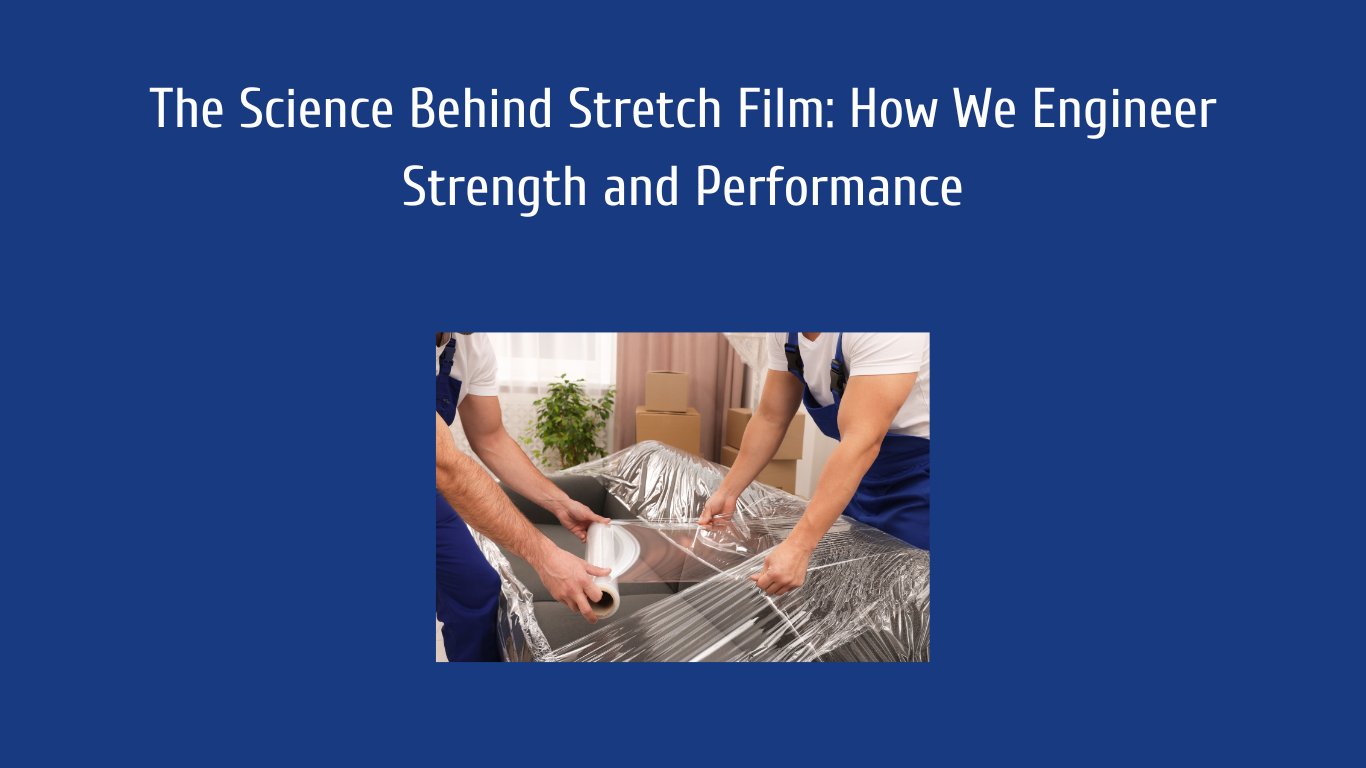Ever wondered how that seemingly simple plastic wrap secures your packages for shipping or keeps your leftovers fresh in the fridge? Stretch film, also known as plastic wrapping roll or packing wrap roll, is a ubiquitous yet often overlooked material that plays a crucial role in a wide array of applications. From protecting products on pallets to preserving food, stretch film’s key properties—strength, flexibility, and cling—make it indispensable. In this blog post, we’ll dive into the science behind stretch film, exploring how it’s engineered for strength and performance and its evolving role in sustainable packaging.
Understanding the Building Blocks: The Chemistry of Stretch Film
The Composition of Stretch Film
Most stretch film is made from Linear Low-Density Polyethylene (LLDPE), a type of polyethylene plastic. The molecular structure of LLDPE features short, branched chains that contribute to its unique properties. These branches prevent the polymer chains from packing closely together, resulting in a material that’s both flexible and tough.
Additives for Enhanced Performance
To further enhance the properties of stretch film, various additives are incorporated during manufacturing. Resins improve the film’s strength and elasticity, while clarifiers increase its transparency. Other additives can be used to provide specific functionalities, such as UV resistance or improved cling properties.
The Art of Engineering Strength: How Stretch Film Gets its Grip
Orientation and Polymer Chain Alignment
One of the engineering marvels behind stretch film’s strength is the process of orientation. During production, the film is stretched, aligning the polymer chains in a way that increases both strength and tear resistance. This orientation process is crucial for creating a film that can securely hold items together without breaking.
Manufacturing Techniques: Blown Film vs. Cast Film
Two primary manufacturing techniques are used to produce stretch film: blown film extrusion and cast film extrusion.
- Blown Film Extrusion: In this method, molten resin is extruded through a circular die to form a tube. Air is then blown into the tube, inflating it like a balloon. The tube is cooled and flattened into a film. This process results in a film with high strength and good puncture resistance but slightly less clarity.
- Cast Film Extrusion: Here, molten resin is extruded through a flat die onto a cooling roll, where it solidifies. This method produces a film with excellent clarity and uniform thickness but slightly lower strength compared to blown film.
Pre-Stretching for Enhanced Performance
Pre-stretching involves elongating the film before it’s applied to a load. This process not only increases the film’s strength but also enables it to conform to irregular shapes while maintaining its holding power. Pre-stretched films are particularly useful for securing loads with sharp edges or uneven surfaces.
Beyond Basic Protection: Unveiling Specialized Stretch Films
Stretch film isn’t a one-size-fits-all solution. Different types of stretch films are designed for specific applications, each offering unique benefits.
High-Clarity Films
High-clarity films are ideal for showcasing products on pallets, allowing for easy identification and visual inspection. These films maintain their transparency even when stretched, ensuring that barcodes and labels remain readable.
Puncture-Resistant Films
Puncture-resistant films are designed to protect delicate items during shipping. These films offer enhanced toughness, reducing the risk of damage from sharp edges or rough handling.
Self-Wound Films
Self-wound films come with built-in cling properties, making them easy to apply without the need for additional adhesives. These films are particularly useful for bundling items together or securing loads quickly and efficiently.
Sustainable Films
As sustainability becomes increasingly important, manufacturers are developing Sustainable stretch films made from recycled materials or bio-based components. These eco-friendly options help reduce environmental impact without compromising performance.
Optimizing Performance: Choosing the Right Stretch Film for the Job
Selecting the right stretch film for your needs involves considering several factors:
- Load Weight: Heavier loads require stronger films with higher tensile strength.
- Application: Different applications, such as palletizing or bundling, may require different types of films.
- Desired Level of Stretch: Some applications benefit from high-stretch films, while others may require films with minimal elongation.
The Role of Stretch Wrap Machines
Stretch wrap machines play a crucial role in optimizing film usage and achieving a secure wrap. These machines ensure consistent tension and application, reducing waste and improving load stability.
The Future of Stretch Film: Innovation and Sustainability
As technology advances, so does the potential for new and improved stretch films. Here are some exciting developments on the horizon:
Nanocomposites
Nanocomposites incorporate nanoparticles into the film matrix, resulting in enhanced strength and puncture resistance. These advanced materials offer superior performance without increasing film thickness.
Self-Healing Films
Imagine a stretch film that can repair minor tears on its own. Self-healing films are in development, promising to further improve the durability and longevity of stretch film applications.
Sustainable Solutions
The push for sustainability is driving the development of biodegradable films and closed-loop recycling programs. These innovations aim to minimize environmental impact and promote circular economy principles.
Conclusion
Stretch film is much more than a simple plastic wrap. Its strength, flexibility, and cling make it an essential material in various industries, from manufacturing to food preservation. The science and engineering behind stretch film are fascinating, showcasing the incredible potential of modern materials and manufacturing techniques.
As we look to the future, continued innovation and a focus on sustainability will ensure that stretch film remains a vital tool for securing and protecting goods. So next time you use a plastic wrapping roll or packing wrap roll, take a moment to appreciate the remarkable technology that goes into making it.

